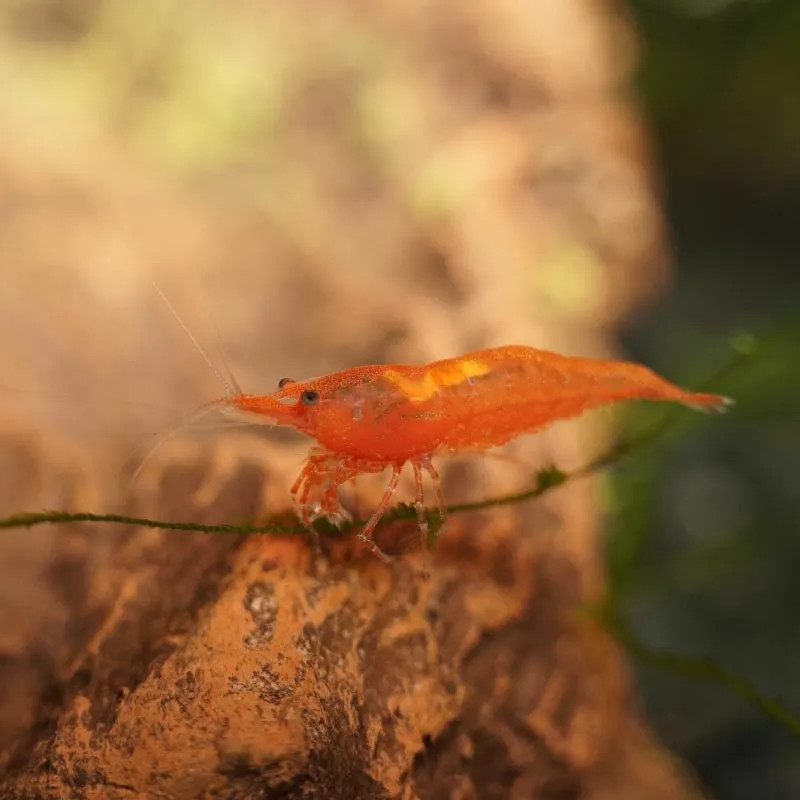Stocks Available
SNOWBALL
SKU:118931
NEOCARIDINA SP.
N/A

Stock Available
Introduction
Species: Neocaridina sp.
Common Names: Orange Bee Shrimp, Orange Honey Shrimp
Natural Habitat
Native to freshwater streams in Southeast Asia, the Orange Bee Shrimp thrives in soft, slightly acidic waters with abundant leaf litter and organic material. Their natural habitats are characterized by clean, slow-moving waters rich in vegetation.
Physical Characteristics
Appearance:
The Orange Bee Shrimp is celebrated for its translucent orange body with delicate honey-like tones. Some individuals may display subtle white or yellowish accents, adding depth to their coloration.
Size:
Typically grows to about 1-1.2 inches (2.5-3 cm) in length.
Lifespan:
Lives 1-2 years with proper care and stable water conditions.
Habitat Requirements
Tank Size:
A minimum of 5 gallons for small colonies; larger tanks are ideal for maintaining stable parameters and accommodating larger groups.
Water Conditions:
Temperature: 68-76°F (20-24°C)
pH: 6.0-6.8 (slightly acidic)
Hardness: Soft water preferred (2-6 dGH).
Aquascaping:
A heavily planted aquarium with mosses, driftwood, and rocks provides ample hiding spots and surfaces for biofilm growth. Fine substrates, such as sand, are ideal for mimicking their natural environment.
Diet
Primary Diet:
Omnivorous; they naturally graze on biofilm, algae, and decaying organic matter.
Supplemental Feeding:
Offer shrimp-specific pellets, algae wafers, and blanched vegetables (e.g., spinach or zucchini). Occasional treats like powdered spirulina or baby brine shrimp enhance their diet.
Feeding Frequency:
Feed small portions daily. Remove uneaten food to maintain water quality.
Compatibility
Temperament:
Peaceful and non-aggressive, Orange Bee Shrimp thrive in groups of 5 or more.
Suitable Tank Mates:
Compatible with nano fish like Ember Tetras, Chili Rasboras, and other small, peaceful species. They also coexist well with other dwarf shrimp species, provided there’s no risk of hybridization.
Incompatibilities:
Avoid housing with larger or predatory fish such as cichlids or fin-nipping species like Tiger Barbs.
Care Level
Difficulty:
Moderate; while hardy, they require consistent water parameters and a well-maintained aquarium.
Health Monitoring:
Observe for signs of molting issues or stress, often caused by poor water quality or lack of calcium. Ensure a stable environment to prevent health issues.
Breeding
Breeding in Captivity:
Relatively straightforward under optimal conditions.
Spawning:
Females carry fertilized eggs under their tails, which hatch into miniature versions of the adults after 25-30 days. Ensure plenty of hiding spots for juveniles to avoid predation.
Economic Considerations
Market Demand:
Popular among shrimp enthusiasts due to their unique coloration and compatibility with planted tanks.
Pricing:
Prices vary based on coloration intensity and lineage, with higher-quality specimens commanding premium prices.
Sustainability and Conservation
Wild Population:
Not endangered but potentially vulnerable to habitat degradation.
Aquaculture Efforts:
Widely bred in captivity to support the growing demand and reduce pressure on wild populations.
Regulations:
Always comply with local laws regarding shrimp trade to ensure ethical practices.
Conclusion
The Orange Bee Shrimp is a captivating addition to any freshwater aquarium, offering both aesthetic appeal and functional benefits by controlling algae and detritus. Their manageable care requirements make them an excellent choice for dedicated aquarists. With a stable habitat and proper nutrition, these shrimp can thrive and become a vibrant highlight in your aquatic community.
Data sheet
16 other products in the same category:
Customers who bought this product also bought: